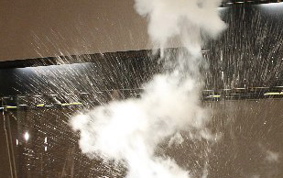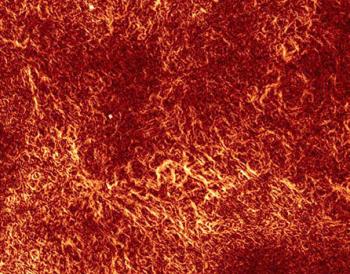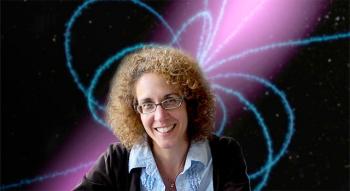 |
 |
 |
 |
 |
 |
 |
 |
 |
 |
|
KICP Workshops & Events
|
Other Events, 2014 Computations in Science Seminar: Juan Collar, University of Chicago, "Uncertainties in dark matter searches" January 22, 2014 | 12:30 PM | KPTC 206 This being a seminar series dedicated to computations, I'll try to communicate the difficulties we have encountered in recent times when attempting to pinpoint the origin of several anomalies affecting dark matter searches, possible hints of detection. These include systematics affecting the operation of the detectors and our knowledge of their response to low-energy nuclear recoils, astrophysical uncertainties, and the broad range of particle couplings that could mediate the interaction of a Weakly Interacting Massive Particle with the target. Perhaps a bit too much to compute. Related Links: KICP Members: Juan I. Collar Physics colloquium: Vyacheslav Turyshev, California Institute of Technology,"Testing Fundamental Gravitation in Space: Recent Progress and Possible Future Directions" January 23, 2014 | 4:15 PM | KPTC 106 Einstein's general theory of relativity is the standard theory of gravitation, especially where the needs of astronomy, astrophysics, cosmology and fundamental physics are concerned. As such, this theory is used for many practical purposes involving spacecraft navigation, geodesy and time transfer. Recent experiments have successfully tested general relativity in a variety of ways to remarkable precision. Various experimental techniques were used to test relativistic gravity in the solar system namely spacecraft Doppler tracking, planetary ranging, lunar laser ranging, dedicated gravity experiments in space and many ground-based efforts. We will discuss the recent progress and the precision achieved by these experiments. Here I review the foundations of general relativity, discuss recent progress in the tests of relativistic gravity, and present motivations for the new generation of high-accuracy gravitational experiments. I discuss the advances in our understanding of fundamental physics that are anticipated in the near future and evaluate the discovery potential of the recently proposed gravitational experiments. Savdeep S. Sethi, University of Chicago, "Domain Walls and Gravity" February 5, 2014 | 12:30 PM | KPTC 206 The coupling of domain walls to gravity leads to a set of questions closely connected to the study of electromagnetism in one spatial dimension. I will discuss the construction of a particularly nice class of domain walls in string theory. The construction suggests a holographic structure that can accommodate accelerating universes. Related Links: KICP Members: Savdeep S. Sethi Joint DES-LSST Workshop March 24 - 27, 2014 | Fermilab Website The Dark Energy Survey officially began several months ago and the progress on the Large Synoptic Survey Telescope has been steady and impressive. The time is ripe for a discussion between people on both projects to share information about tools and lessons learned, and discuss future synergistic activities. Read more >> Physics colloquium: Adam Riess, "The Hubble Constant and Dark Energy from Supernovae, Cepheids and Parallax" April 24, 2014 | 4:15 PM | KPTC 106 The Hubble constant remains one of the most important parameters in the cosmological model, setting the size and age scales of the Universe. Present uncertainties in the cosmological model including the nature of dark energy, the properties of neutrinos and the scale of departures from flat geometry can be constrained by measurements of the Hubble constant made to higher precision than was possible with the first generations of Hubble Telescope instruments. Streamlined distances ladders constructed from infrared observations of Cepheids and type Ia supernovae with ruthless attention paid to systematics now provide 3.5% precision and offer the means to do much better. While WFC3 has helped open this new route, its full exploitation can come from a new technique, Parallel Astrometric Spatial Scanning (PASS), to measure parallax distances beyond a kiloparsec. I will review recent and expected progress. Flash Center Special Seminar: Christian Ott, Caltech, "New Aspects of Core-Collapse Supernova Theory" June 12, 2014 | 3:00 PM | LASR conference room Core-collapse supernovae from massive stars are among the most energetic events in the universe. They liberate a mass-energy equivalent of ~15% of a solar mass in the collapse of their progenitor star's core. The majority (~99%) of this energy is carried away by neutrinos, while (~1%) is transferred to the kinetic energy of the explosive outflow. A smaller, yet still tremendous amount of energy is emitted in electromagnetic and gravitational waves. The stellar collapse phenomenon and its range of outcomes pose a formidable challenge to computational modeling. I discuss recent progress made with multi-dimensional simulations and highlight (i) the potential impact of asphericity from unstable convective shell burning in the progenitor star and (ii) first full 3D results on the magnetorotational explosion mechanism that is considered in the context of hyperenergetic core-collapse supernova explosions and long gamma-ray bursts. Finally, I outline how detection of gravitational waves and neutrinos from the next nearby core collapse event can help to observationally probe the dynamics and thermodynamics of the supernova engine. Computations in Science Seminar: Neil Turok, Perimeter Institute, "On Quantum Tunneling" July 10, 2014 | 1:30 PM | ACC 211 One of the most basic but intriguing properties of quantum systems is their ability to 'tunnel' between configurations which are classically disconnected. That is, processes which are classically impossible are allowed by quantum tunneling. In this talk I will outline a new, first-principles approach combining the semi-classical approximation with the concepts of post-selection and weak measurement. Its main virtue is to provide a real-time description within which sharp answers can be given to questions such as 'how long did the tunneling take' and 'where was the particle while it was tunneling?' Potential applications span a vast range, from laboratory tests to black holes and cosmology. Workshop: "Structuring Your Scientific Paper" September 24, 2014 | KPTC 105  Instructor: Jean-luc Doumont, Founding Partner, Principiae An engineer from the Louvain School of Engineering and PhD in applied physics from Stanford University, Jean-luc Doumont now devotes his time and energy to training engineers, scientists, business people, and other rational minds in effective communication, pedagogy, statistical thinking, and related themes. Articulate, entertaining, and thought-provoking, Doumont is a popular invited instructor worldwide, in particular at international scientific conferences, research laboratories, and research universities. For additional information, visit www.principiae.be. Session Papers are central to the work of researchers. Well-designed, they efficiently allow each reader to learn only what he or she needs to. Poorly designed, by contrast, they confuse readers, fail to prompt decisions, or remain unread. Based on Jean-luc Doumont's book Trees, maps, and theorems about "effective communication for rational minds," the session shows how to structure scientific papers, theses, and technical reports effectively at all levels to get the readers' attention, facilitate navigation, and, in this way, get the message across. Practically, the session proceeds as a group discussion, on the basis of sample papers sent by the participants ahead of time. This highly interactive approach builds on the participants' previous experience (as authors or as readers), self-adapts to their current level, accommodates non-homogeneous groups, and makes for an engaging and pleasant learning experience. The use of the participants' own examples ensures a relevant discussion and facilitates the transfer of what they have learned to their writing after the session. 2014 Brinson Lecture: Victoria M. Kaspi, "Neutron Stars, a Cosmic Gift" November 5, 2014 | 6:00 PM | School of the Art Institute of Chicago Website Victoria M. Kaspi, 2014 Brinson Lecturer Astrophysicist Victoria M. Kaspi is a world leader on neutron stars and pulsars, the remarkable objects formed during the death of massive stars. She a Professor in the Department of Physics at McGill University and holds the Lorne Trottier Chair in Astrophysics and Cosmology as well as a Canada Research Chair. She obtained her PhD in Physics from Princeton University and held a Hubble Postdoctoral Fellowship at the California Institute of Technology and MIT where she was also faculty. Her honors include the NSERC John C. Polanyi Award and the Killam Research Fellowship in 2010, and the Rutherford Memorial Medal in Physics in 2007. She is Fellow of the Royal Society of Canada, the Royal Society of London and the US National Academy of Sciences. 2014 Brinson Lecture: "Neutron Stars, a Cosmic Gift" Although they are thousands of light years away, neutron stars can act as very precise cosmic beacons; a cosmic gift that sheds light on some of the most interesting problems in modern science. We will explore these strange objects, explain how astronomers are using them to study issues ranging from the origins of the Universe to the very nature of matter; and even listen to the cosmic symphony they create. This event is co-sponsored by the University of Chicago and the School of the Art Institute of Chicago. Read more >> Physics colloquium: Victoria M. Kaspi, McGill University, "The Hunt for Millisecond Pulsars" November 6, 2014 | 4:00 PM | KPTC 106  Physics with a Bang! Holiday Lecture and Open House December 6, 2014 | 11:00 AM | Kersten Physics Teaching Center  Astronomy Special Seminar: Blakesley Burkhart, Harvard University, "New Frontiers of Magnetized Turbulence in the Multiphase Interstellar Medium" December 9, 2014 | 12:00 PM | LASR conference room  |






 Overview
Overview